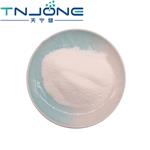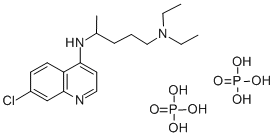What is Chloroquine diphosphate?
Apr 22,2021
Properties
Chemical name: N4-(7-Chloro-4-quinolinyl)-N1,N1-dimethyl-1,4-pentanediamine diphosphate salt
Molecular Weight: 515.86
Chemical structure: 
Molecular Formula: C18H26ClN3?2H3PO4
CAS Number: 50-63-5
PubChem identifier: 64927
SMILES: CCN(CC)CCCC(C)NC2=CC=NC1=CC(Cl)=CC=C12.O=P(O)(O)O.O=P(O)(O)O
InChi: InChI=1S/C18H26ClN3.2H3O4P/c1-4-22(5-2)12-6-7-14(3)21-17-10-11-20-18-13-15(19)8-9-16(17)18;2*1-5(2,3)4/h8-11,13-14H,4-7,12H2,1-3H3,(H,20,21);2*(H3,1,2,3,4)
InChiKey: QKICWELGRMTQCR-UHFFFAOYSA-N
MDL number: MFCD00069852
Chloroquine diphosphate is a derivative of 4-aminoquinoline, which is an inhibitor of autophagy and has antimalarial and anticancer activities.1-3) In addition, chloroquine has been also reported to exert anti-corona viral activity in vitro.4) The mechanism of action of chloroquine is not completely understood. But, some studies have demonstrated that chloroquine is a weak base and may exert its effect by concentrating in the acid vesicles of the parasite and by inhibiting polymerization of heme. In addition, while chloroquine can inhibit certain enzymes, its effect is believed to result, at least in part from its interaction with DNA. (The product is for research purpose only.)
Biological activity
Chloroquine diphosphate inhibits cell growth and induces cell death in numerous cancer cell lines; inhibits cell proliferation and viability and induces apoptosis in 4T1 mouse breast cancer cells in vitro. Exhibits antimetastatic activity. Also inhibits autophagy via a mechanism distinct from that of 3-methyladenine (Cat. No. 3977). Blocks receptor-mediated endocytosis of mannose-glycoconjugates by macrophages. Inhibits SARS-CoV-2 infection in vitro (EC50 = 1.13 μM).
In Vitro
Chloroquine diphosphate Inhibits tumor cell growth and metastasis and induces apoptosis in vitro. Binds to Fe(II)-protoporphyrin IX (FP) to form FP-chloroquine complex resulting in cell lysis and parasite cell autodigestion.
Antimalarial compound with various biological actions (anti-inflammatory, immunomodulatory, antiviral, anticancer etc.). It inhibits cell growth, proliferation and viability and also induces apoptosis and autophagy. It inhibits viral replication to show antiviral activity and inhibits SARS-CoV-2 viral infection (COVID-19) in vitro.
- Related articles
- Related Qustion
- Chloroquine Diphosphate: Adverse Effects and Degradation Pathways Feb 4, 2024
Chloroquine diphosphate has adverse effects and is susceptible to degradation. Proper storage and avoidance of interactions are crucial.
- Chloroquine diphosphate: pharmacokinetics and clinical applications Jul 20, 2023
Chloroquine diphosphate can treat malaria and amebiasis, also used for managing rheumatoid arthritis.
Palladium(II) acetate is a chemical compound of palladium described by the formula [Pd(O2CCH3)2]n, abbreviated [Pd(OAc)2]n. It is more reactive than the analogous platinum compound.....
Apr 22,2021Organometallic compoundsMethanesulfonic acid appears as colorless or slightly brown oily liquid, appearing as solid at low temperatures.It also has strong corrosion effect against the metal iron, copper and lead.It can be used as solvent, alkylation.....
Apr 22,2021Organic reagentsChloroquine diphosphate
50-63-5You may like
- Pyriofenone: Synthesis and Application
Feb 5, 2024
- How is Picarbutrazox synthesised and what does it do?
Feb 5, 2024
- How is Tolprocarb synthesised?
Feb 4, 2024
Chloroquine diphosphate manufacturers
- Chloroquine Phosphate ;Chloroquine Diphosphate
-

- $0.00 / 1kg
- 2024-05-16
- CAS:50-63-5
- Min. Order: 1kg
- Purity: 99%
- Supply Ability: 10000kg
- Chloroquine diphosphate
-

- $15.00/ kg
- 2024-04-28
- CAS:50-63-5
- Min. Order: 1kg
- Purity: 99.912%
- Supply Ability: 10ton
- Chloroquine diphosphate
-

- $0.00 / 1KG
- 2024-03-16
- CAS:50-63-5
- Min. Order: 100g
- Purity: 98%+
- Supply Ability: 100kg




